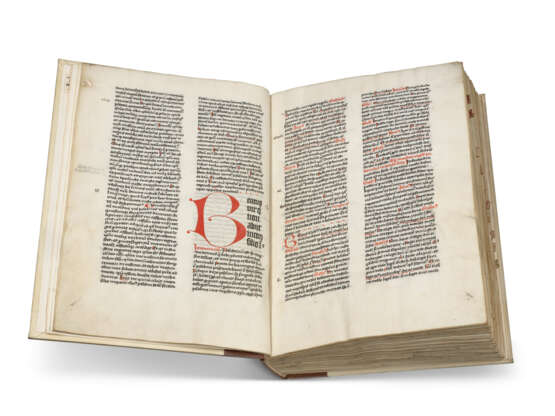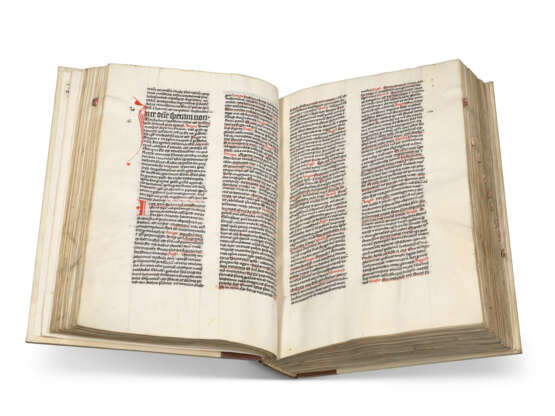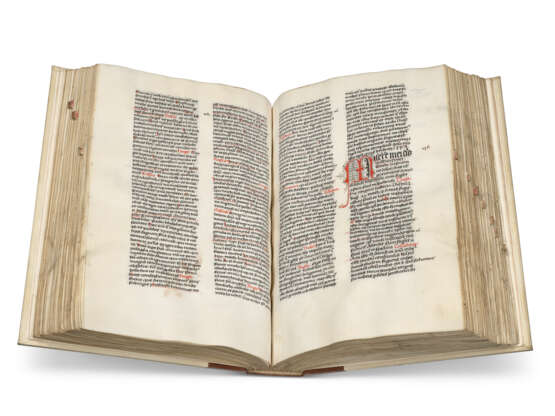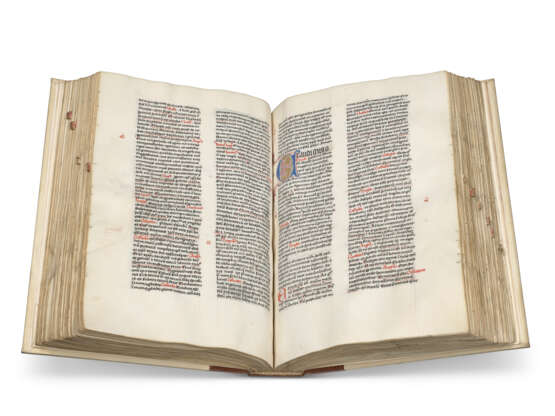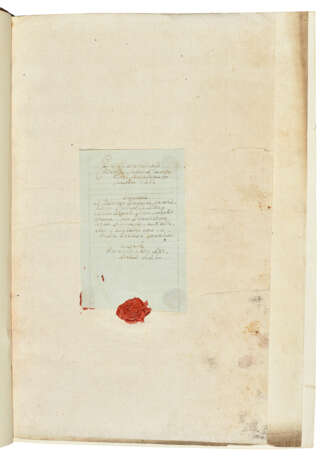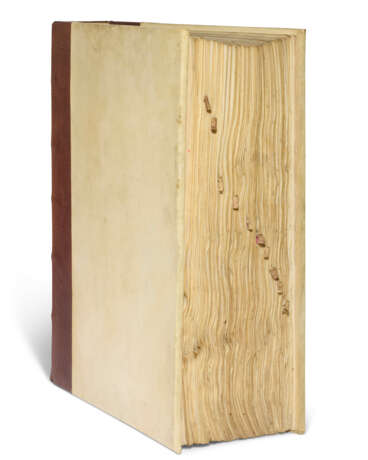ID 1349637
Lot 12 | Peter of Herenthal (1322-1391)
Valeur estimée
£ 10 000 – 15 000
Collectarius super Librum Psalmorum, Commentary on the Psalms, in Latin, manuscript on vellum [Germany] 1462
An important medieval commentary on the Psalms by the Prior of Floreffe Peter of Herenthal, written by Brother Jodocus in 1462 and once in the Library of St Martin’s Church at Unterkirchberg.
403 x 285mm. ii (modern paper) + ii (old paper) + i (modern paper) + 254 + iii (modern paper) leaves, complete, collation: 19 (of 10, i a cancelled blank), 2-1810, 199 (of 10, x a cancelled blank), 20-2210, 239 (of 10, no text missing but the scribe in a red rubric notes an error in the binding where the penultimate leaf of the gathering should follow the last), 24-2510, 267 (of 8, viii a cancelled blank), two columns of 47-52 lines, ruled space: 300 x 85mm, rubrics and initials in red, capitals touched in red, catchwords sporadically survive, early annotations, leather tabs (margins cropped affecting marginal annotations, minor worming, original flaws in the vellum, generally in excellent condition). Bound in modern vellum over wooden boards, the spine roan tooled in gilt.
Provenance:
(1) The manuscript was written by Brother Jodocus, who finished it on 20 January 1462, his colophon on f.254v: ‘Scriptus per fratrem Jodocum et finitus anno a nativitate Domini 1462 in die Sanctorum Fabiani et Sebastiani’.
(2) St Martin’s Church at Unterkirchberg, Germany, c.1800: note attached to the first old paper flyleaf with a red wax armorial seal. The parish church of St Martin was built in 1517 at the behest of the abbot of Wiblingen Monastery Georg Hackner. The manuscript, according to the note, was intended for use on the occasion of the death of someone of importance, for the inauguration of the main altar, or for ‘alterius utilitatis in dicta Ecclesia parochiali’. The note is signed ‘Curante Amandi Storr Par. Pretius’: this is Pastor Amandus Storr, under whose governance the church had to be repaired in 1800 after an attack by French soldiers; it was given a new pavement, new confessionals were installed and altars replaced. Also between 1799-1818, numerous new oil paintings were acquired. It is plausible that it was at this time of renewal in the church’s history that the manuscript came into their possession.
(3) William Ewart Gladstone, Prime Minister (1809-1898): Hawarden Castle library label, MM II 7. A note slipped in at the front reads: ‘The Bible Vol. I. Removal to glass case. Ap. 23 1934. A.B.’
Contents: Peter of Herenthal (1322-1391), Collectarius super Librum Psalmorum, ff.1-254v, beginning ‘Patri reuerendo dominoque meo carissimo domino Iohanni de Arkel’, f.1, with Psalm 1: ‘Beatus vir […] Psalterium est quasi magna domus’ f.3v.
Peter of Herenthal (1322-1391) entered the Premonstratensian Abbey of Floreffe in 1342 after twelve years of study and a failed attempt to receive a benefice from Pope Clement VI at Avignon. Chaplain and subsequently Prior at Floreffe under Thierry de Warmant (1342-61), his works include a history of the emperors and popes of Rome, an account of the abbots of Floreffe, and a collection of commentaries on the Gospels. He is best known though for his Collectarius super librum Psalmorum, a verse-by-verse commentary on the Psalms which survives today in nine printed editions of the late 15th and early 16th centuries (the earliest of which was Cologne, 1480, Goff P471), and at least 40 manuscript copies.
Peter’s attempt to compile and reconcile commentaries on each of the Psalms from the Church Fathers, such as Augustine, Jerome, Gregory the Great and Cassiodorus with texts from more recent medieval writers, such as Rémi of Auxerre, Hugh of Saint-Victor and Nicolas of Lyra, remains an important medieval witness to these patristic sources. The work was undertaken in 1374 (as stated in the colophon of the present manuscript) at the request of Jean d’Arkel, Bishop of Utrecht and Liège.
| Lieu d'origine: | Europe de l'Ouest, Allemagne, Europe |
|---|---|
| Catégorie maison de vente aux enchères: | Manuscrits médiévaux et de la Renaissance, Livres et manuscrits |
| Lieu d'origine: | Europe de l'Ouest, Allemagne, Europe |
|---|---|
| Catégorie maison de vente aux enchères: | Manuscrits médiévaux et de la Renaissance, Livres et manuscrits |
| Adresse de l'enchère |
CHRISTIE'S 8 King Street, St. James's SW1Y 6QT London Royaume-Uni | |
|---|---|---|
| Aperçu |
| |
| Téléphone | +44 (0)20 7839 9060 | |
| Commission | see on Website | |
| Conditions d'utilisation | Conditions d'utilisation |
